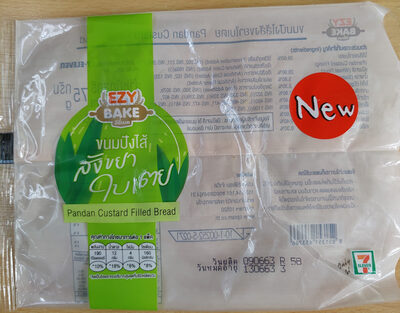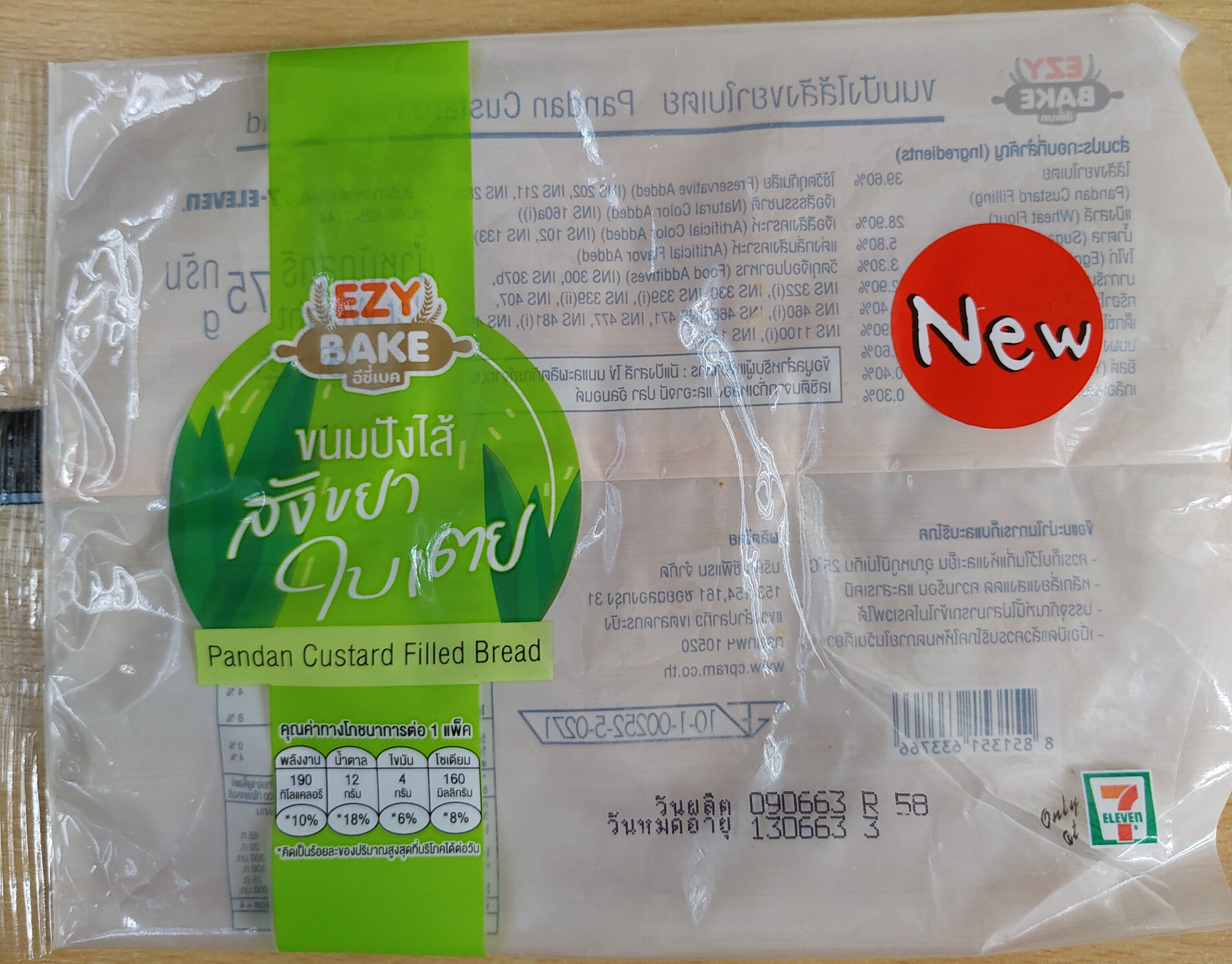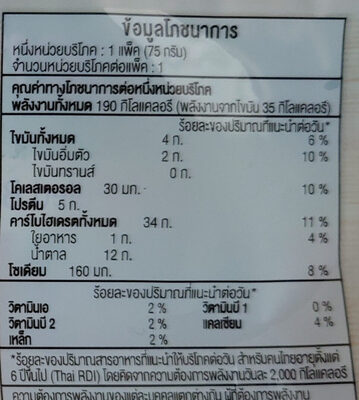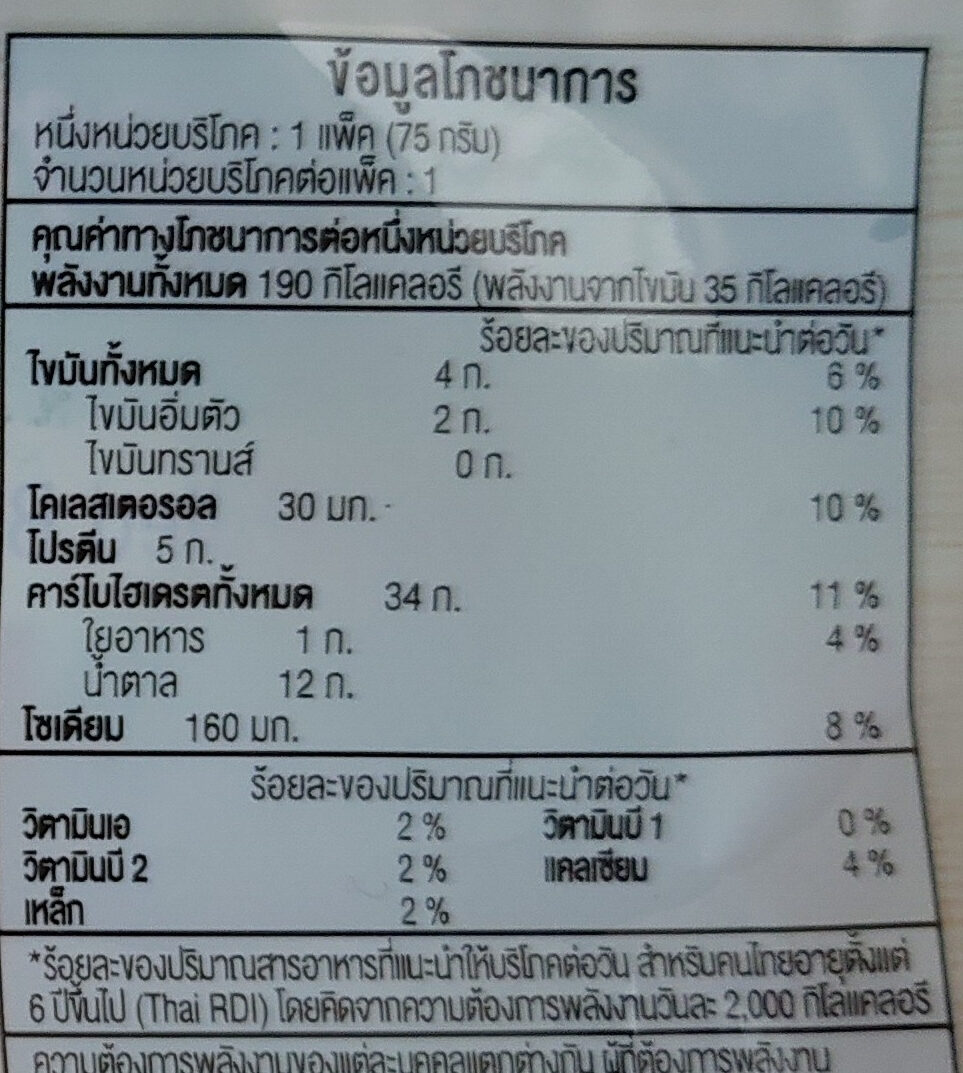Help us make food transparency the norm!
As a non-profit organization, we depend on your donations to continue informing consumers around the world about what they eat.
The food revolution starts with you!
ขนมปังไส้สังขยาใบเตย - EzyBake - 75 g
ขนมปังไส้สังขยาใบเตย - EzyBake - 75 g
This product page is not complete. You can help to complete it by editing it and adding more data from the photos we have, or by taking more photos using the app for Android or iPhone/iPad. Thank you!
×
Barcode: 8851351633766 (EAN / EAN-13)
Quantity: 75 g
Packaging: Bag
Brands: EzyBake
Categories: Plant-based foods and beverages, Plant-based foods, Cereals and potatoes, Breads
Countries where sold: Thailand
Matching with your preferences
Health
Ingredients
-
49 ingredients
: ไส้สังขยาใบเตย (Pandan Custard Filling) 39.60% แป้งสาลี (Wheat Flour) 28.90% น้ำตาล (Sugar) 5.80% ไข่ไก่ (Egg) 3.30% มาการีน (Margarine) 2.90% ทรีฮาโลส (Trehalose) 1.40% เด็กซ์โตรส (Dextrose) 0.90% นมผง(Milk Powder) 0.60% ยีสต์ (Veast) 0.40% เกลือเสริมไอโอดีน 0.30% ใช้วัตถุกันเสีย (Preservative Added) (INS 202, INS 211, INS 282) เจือสีธรรมชาติ (Natural Color Added) (INS 160a(i)) เจือสีสังเคราะห์ (Artificial Color Added) (INS 102, INS 133) แต่งกลิ่นสังเคราะห์ (Artificial Flavor Added) วัตถุเจือปนอาหาร (Food Additives) (INS 300, INS 307b, INS 322(i), INS 330, INS 339(i), INS 339(ii), INS 407, _ INS 460(i), INS 466, INS 471, INS 477, INS 481 (i), INS 491, INS 1100(i), INS 1442)Allergens: Eggs, Fish, Gluten, Milk, Nuts, SoybeansTraces: Eggs, Gluten, Milk
Food processing
-
Ultra processed foods
Elements that indicate the product is in the 4 - Ultra processed food and drink products group:
- Additive: E102 - Tartrazine
- Additive: E1442 - Hydroxypropyl distarch phosphate
- Additive: E322 - Lecithins
- Additive: E407 - Carrageenan
- Additive: E460 - Cellulose
- Additive: E466 - Sodium carboxy methyl cellulose
- Additive: E471 - Mono- and diglycerides of fatty acids
- Additive: E477 - Propane-1‚2-diol esters of fatty acids
- Additive: E491 - Sorbitan monostearate
Food products are classified into 4 groups according to their degree of processing:
- Unprocessed or minimally processed foods
- Processed culinary ingredients
- Processed foods
- Ultra processed foods
The determination of the group is based on the category of the product and on the ingredients it contains.
Additives
-
E102 - Tartrazine
Tartrazine: Tartrazine is a synthetic lemon yellow azo dye primarily used as a food coloring. It is also known as E number E102, C.I. 19140, FD&C Yellow 5, Acid Yellow 23, Food Yellow 4, and trisodium 1--4-sulfonatophenyl--4--4-sulfonatophenylazo--5-pyrazolone-3-carboxylate-.Tartrazine is a commonly used color all over the world, mainly for yellow, and can also be used with Brilliant Blue FCF -FD&C Blue 1, E133- or Green S -E142- to produce various green shades.Source: Wikipedia
-
E1442 - Hydroxypropyl distarch phosphate
Hydroxypropyl distarch phosphate: Hydroxypropyl distarch phosphate -HDP- is a modified resistant starch. It is currently used as a food additive -INS number 1442-. It is approved for use in the European Union -listed as E1442-, the United States, Australia, Taiwan, and New Zealand.Source: Wikipedia
-
E202 - Potassium sorbate
Potassium sorbate (E202) is a synthetic food preservative commonly used to extend the shelf life of various food products.
It works by inhibiting the growth of molds, yeast, and some bacteria, preventing spoilage. When added to foods, it helps maintain their freshness and quality.
Some studies have shown that when combined with nitrites, potassium sorbate have genotoxic activity in vitro. However, potassium sorbate is generally recognized as safe (GRAS) by regulatory authorities.
-
E211 - Sodium benzoate
Sodium benzoate: Sodium benzoate is a substance which has the chemical formula NaC7H5O2. It is a widely used food preservative, with an E number of E211. It is the sodium salt of benzoic acid and exists in this form when dissolved in water. It can be produced by reacting sodium hydroxide with benzoic acid.Source: Wikipedia
-
E307b - Concentrated tocopherol
Alpha-Tocopherol: α-Tocopherol is a type of vitamin E. It has E number "E307". Vitamin E exists in eight different forms, four tocopherols and four tocotrienols. All feature a chromane ring, with a hydroxyl group that can donate a hydrogen atom to reduce free radicals and a hydrophobic side chain which allows for penetration into biological membranes. Compared to the others, α-tocopherol is preferentially absorbed and accumulated in humans.Source: Wikipedia
-
E322 - Lecithins
Lecithins are natural compounds commonly used in the food industry as emulsifiers and stabilizers.
Extracted from sources like soybeans and eggs, lecithins consist of phospholipids that enhance the mixing of oil and water, ensuring smooth textures in various products like chocolates, dressings, and baked goods.
They do not present any known health risks.
-
E322i - Lecithin
Lecithins are natural compounds commonly used in the food industry as emulsifiers and stabilizers.
Extracted from sources like soybeans and eggs, lecithins consist of phospholipids that enhance the mixing of oil and water, ensuring smooth textures in various products like chocolates, dressings, and baked goods.
They do not present any known health risks.
-
E330 - Citric acid
Citric acid is a natural organic acid found in citrus fruits such as lemons, oranges, and limes.
It is widely used in the food industry as a flavor enhancer, acidulant, and preservative due to its tart and refreshing taste.
Citric acid is safe for consumption when used in moderation and is considered a generally recognized as safe (GRAS) food additive by regulatory agencies worldwide.
-
E339 - Sodium phosphates
Sodium phosphates: Sodium phosphate is a generic term for a variety of salts of sodium -Na+- and phosphate -PO43−-. Phosphate also forms families or condensed anions including di-, tri-, tetra-, and polyphosphates. Most of these salts are known in both anhydrous -water-free- and hydrated forms. The hydrates are more common than the anhydrous forms.Source: Wikipedia
-
E339i - Monosodium phosphate
Sodium phosphates: Sodium phosphate is a generic term for a variety of salts of sodium -Na+- and phosphate -PO43−-. Phosphate also forms families or condensed anions including di-, tri-, tetra-, and polyphosphates. Most of these salts are known in both anhydrous -water-free- and hydrated forms. The hydrates are more common than the anhydrous forms.Source: Wikipedia
-
E339ii - Disodium phosphate
Sodium phosphates: Sodium phosphate is a generic term for a variety of salts of sodium -Na+- and phosphate -PO43−-. Phosphate also forms families or condensed anions including di-, tri-, tetra-, and polyphosphates. Most of these salts are known in both anhydrous -water-free- and hydrated forms. The hydrates are more common than the anhydrous forms.Source: Wikipedia
-
E407 - Carrageenan
Carrageenan (E407), derived from red seaweed, is widely employed in the food industry as a gelling, thickening, and stabilizing agent, notably in dairy and meat products.
It can exist in various forms, each imparting distinct textural properties to food.
However, its degraded form, often referred to as poligeenan, has raised health concerns due to its potential inflammatory effects and its classification as a possible human carcinogen (Group 2B) by the International Agency for Research on Cancer (IARC).
Nevertheless, food-grade carrageenan has been deemed safe by various regulatory bodies when consumed in amounts typically found in food.
-
E460 - Cellulose
Cellulose: Cellulose is an organic compound with the formula -C6H10O5-n, a polysaccharide consisting of a linear chain of several hundred to many thousands of β-1→4- linked D-glucose units. Cellulose is an important structural component of the primary cell wall of green plants, many forms of algae and the oomycetes. Some species of bacteria secrete it to form biofilms. Cellulose is the most abundant organic polymer on Earth. The cellulose content of cotton fiber is 90%, that of wood is 40–50%, and that of dried hemp is approximately 57%.Cellulose is mainly used to produce paperboard and paper. Smaller quantities are converted into a wide variety of derivative products such as cellophane and rayon. Conversion of cellulose from energy crops into biofuels such as cellulosic ethanol is under development as a renewable fuel source. Cellulose for industrial use is mainly obtained from wood pulp and cotton.Some animals, particularly ruminants and termites, can digest cellulose with the help of symbiotic micro-organisms that live in their guts, such as Trichonympha. In human nutrition, cellulose is a non-digestible constituent of insoluble dietary fiber, acting as a hydrophilic bulking agent for feces and potentially aiding in defecation.Source: Wikipedia
-
E460i - Microcrystalline cellulose
Cellulose: Cellulose is an organic compound with the formula -C6H10O5-n, a polysaccharide consisting of a linear chain of several hundred to many thousands of β-1→4- linked D-glucose units. Cellulose is an important structural component of the primary cell wall of green plants, many forms of algae and the oomycetes. Some species of bacteria secrete it to form biofilms. Cellulose is the most abundant organic polymer on Earth. The cellulose content of cotton fiber is 90%, that of wood is 40–50%, and that of dried hemp is approximately 57%.Cellulose is mainly used to produce paperboard and paper. Smaller quantities are converted into a wide variety of derivative products such as cellophane and rayon. Conversion of cellulose from energy crops into biofuels such as cellulosic ethanol is under development as a renewable fuel source. Cellulose for industrial use is mainly obtained from wood pulp and cotton.Some animals, particularly ruminants and termites, can digest cellulose with the help of symbiotic micro-organisms that live in their guts, such as Trichonympha. In human nutrition, cellulose is a non-digestible constituent of insoluble dietary fiber, acting as a hydrophilic bulking agent for feces and potentially aiding in defecation.Source: Wikipedia
-
E466 - Sodium carboxy methyl cellulose
Carboxymethyl cellulose: Carboxymethyl cellulose -CMC- or cellulose gum or tylose powder is a cellulose derivative with carboxymethyl groups --CH2-COOH- bound to some of the hydroxyl groups of the glucopyranose monomers that make up the cellulose backbone. It is often used as its sodium salt, sodium carboxymethyl cellulose.Source: Wikipedia
-
E471 - Mono- and diglycerides of fatty acids
Mono- and diglycerides of fatty acids (E471), are food additives commonly used as emulsifiers in various processed foods.
These compounds consist of glycerol molecules linked to one or two fatty acid chains, which help stabilize and blend water and oil-based ingredients. E471 enhances the texture and shelf life of products like margarine, baked goods, and ice cream, ensuring a smooth and consistent texture.
It is generally considered safe for consumption within established regulatory limits.
-
E491 - Sorbitan monostearate
Sorbitan monostearate: Sorbitan monostearate is an ester of sorbitan -a sorbitol derivative- and stearic acid and is sometimes referred to as a synthetic wax. It is primarily used as an emulsifier to keep water and oils mixed. Sorbitan monostearate is used in the manufacture of food and healthcare products and is a non-ionic surfactant with emulsifying, dispersing, and wetting properties. It is also employed to create synthetic fibers, metal machining fluid, and brighteners in the leather industry, and as an emulsifier in coatings, pesticides, and various applications in the plastics, food and cosmetics industries. Sorbitans are also known as "Spans". Sorbitan monostearate has been approved by the European Union for use as a food additive -emulsifier- -E number: E 491-Source: Wikipedia
Ingredients analysis
-
May contain palm oil
Ingredients that may contain palm oil: E160ai, E471
-
Vegan status unknown
Unrecognized ingredients: th:ไส้สังขยาใบเตย, th:pandan-custard-filling, th:wheat-flour, th:sugar, th:ไข่ไก่, th:egg, th:มาการีน, th:margarine, th:ทรีฮาโลส, th:trehalose, th:เด็กซ์โตรส, th:dextrose, th:นมผง, th:milk-powder, th:veast, th:เกลือเสริมไอโอดีน-0-3-ใช้วัตถุกันเสีย, th:preservative-added, th:เจือสีธรรมชาติ, th:natural-color-added, th:เจือสีสังเคราะห์, th:artificial-color-added, th:แต่งกลิ่นสังเคราะห์, th:artificial-flavor-added, th:วัตถุเจือปนอาหาร, th:food-additives, E339ii, th:e481i, th:e1100iSome ingredients could not be recognized.
We need your help!
You can help us recognize more ingredients and better analyze the list of ingredients for this product and others:
- Edit this product page to correct spelling mistakes in the ingredients list, and/or to remove ingredients in other languages and sentences that are not related to the ingredients.
- Add new entries, synonyms or translations to our multilingual lists of ingredients, ingredient processing methods, and labels.
If you would like to help, join the #ingredients channel on our Slack discussion space and/or learn about ingredients analysis on our wiki. Thank you!
-
Vegetarian status unknown
Unrecognized ingredients: th:ไส้สังขยาใบเตย, th:pandan-custard-filling, th:wheat-flour, th:sugar, th:ไข่ไก่, th:egg, th:มาการีน, th:margarine, th:ทรีฮาโลส, th:trehalose, th:เด็กซ์โตรส, th:dextrose, th:นมผง, th:milk-powder, th:veast, th:เกลือเสริมไอโอดีน-0-3-ใช้วัตถุกันเสีย, th:preservative-added, th:เจือสีธรรมชาติ, th:natural-color-added, th:เจือสีสังเคราะห์, th:artificial-color-added, th:แต่งกลิ่นสังเคราะห์, th:artificial-flavor-added, th:วัตถุเจือปนอาหาร, th:food-additives, E339ii, th:e481i, th:e1100iSome ingredients could not be recognized.
We need your help!
You can help us recognize more ingredients and better analyze the list of ingredients for this product and others:
- Edit this product page to correct spelling mistakes in the ingredients list, and/or to remove ingredients in other languages and sentences that are not related to the ingredients.
- Add new entries, synonyms or translations to our multilingual lists of ingredients, ingredient processing methods, and labels.
If you would like to help, join the #ingredients channel on our Slack discussion space and/or learn about ingredients analysis on our wiki. Thank you!
-
Details of the analysis of the ingredients
We need your help!
Some ingredients could not be recognized.
We need your help!
You can help us recognize more ingredients and better analyze the list of ingredients for this product and others:
- Edit this product page to correct spelling mistakes in the ingredients list, and/or to remove ingredients in other languages and sentences that are not related to the ingredients.
- Add new entries, synonyms or translations to our multilingual lists of ingredients, ingredient processing methods, and labels.
If you would like to help, join the #ingredients channel on our Slack discussion space and/or learn about ingredients analysis on our wiki. Thank you!
: ไส้สังขยาใบเตย (Pandan Custard Filling), แป้งสาลี 39.6% (Wheat Flour), น้ำตาล 28.9% (Sugar), ไข่ไก่ 5.8% (Egg), มาการีน 3.3% (Margarine), ทรีฮาโลส 2.9% (Trehalose), เด็กซ์โตรส 1.4% (Dextrose), นมผง 0.9% (Milk Powder), ยีสต์ 0.6% (Veast), เกลือเสริมไอโอดีน 0.30% ใช้วัตถุกันเสีย 0.4% (Preservative Added, e202, e211, e282), เจือสีธรรมชาติ (Natural Color Added, e160ai), เจือสีสังเคราะห์ (Artificial Color Added, e102, e133), แต่งกลิ่นสังเคราะห์ (Artificial Flavor Added), วัตถุเจือปนอาหาร (Food Additives, e300, e307b, e322i, e330, e339i, e339ii, e407, _ e460i, e466, e471, e477, e481i, e491, e1100i, e1442)- ไส้สังขยาใบเตย -> th:ไส้สังขยาใบเตย
- Pandan Custard Filling -> th:pandan-custard-filling
- แป้งสาลี -> en:wheat-flour - vegan: yes - vegetarian: yes - ciqual_proxy_food_code: 9410 - percent: 39.6
- Wheat Flour -> th:wheat-flour
- น้ำตาล -> en:sugar - vegan: yes - vegetarian: yes - ciqual_proxy_food_code: 31016 - percent: 28.9
- Sugar -> th:sugar
- ไข่ไก่ -> th:ไข่ไก่ - percent: 5.8
- Egg -> th:egg
- มาการีน -> th:มาการีน - percent: 3.3
- Margarine -> th:margarine
- ทรีฮาโลส -> th:ทรีฮาโลส - percent: 2.9
- Trehalose -> th:trehalose
- เด็กซ์โตรส -> th:เด็กซ์โตรส - percent: 1.4
- Dextrose -> th:dextrose
- นมผง -> th:นมผง - percent: 0.9
- Milk Powder -> th:milk-powder
- ยีสต์ -> en:yeast - vegan: yes - vegetarian: yes - percent: 0.6
- Veast -> th:veast
- เกลือเสริมไอโอดีน 0.30% ใช้วัตถุกันเสีย -> th:เกลือเสริมไอโอดีน-0-3-ใช้วัตถุกันเสีย - percent: 0.4
- Preservative Added -> th:preservative-added
- e202 -> en:e202 - vegan: yes - vegetarian: yes
- e211 -> en:e211 - vegan: yes - vegetarian: yes
- e282 -> en:e282 - vegan: yes - vegetarian: yes
- เจือสีธรรมชาติ -> th:เจือสีธรรมชาติ
- Natural Color Added -> th:natural-color-added
- e160ai -> en:e160ai - vegan: maybe - vegetarian: maybe - from_palm_oil: maybe
- เจือสีสังเคราะห์ -> th:เจือสีสังเคราะห์
- Artificial Color Added -> th:artificial-color-added
- e102 -> en:e102 - vegan: yes - vegetarian: yes
- e133 -> en:e133 - vegan: yes - vegetarian: yes
- แต่งกลิ่นสังเคราะห์ -> th:แต่งกลิ่นสังเคราะห์
- Artificial Flavor Added -> th:artificial-flavor-added
- วัตถุเจือปนอาหาร -> th:วัตถุเจือปนอาหาร
- Food Additives -> th:food-additives
- e300 -> en:e300 - vegan: yes - vegetarian: yes
- e307b -> en:e307b - vegan: yes - vegetarian: yes
- e322i -> en:e322i - vegan: maybe - vegetarian: maybe
- e330 -> en:e330 - vegan: yes - vegetarian: yes
- e339i -> en:e339i - vegan: yes - vegetarian: yes
- e339ii -> en:e339ii
- e407 -> en:e407 - vegan: yes - vegetarian: yes
- _ e460i -> en:e460i - vegan: yes - vegetarian: yes
- e466 -> en:e466 - vegan: yes - vegetarian: yes
- e471 -> en:e471 - vegan: maybe - vegetarian: maybe - from_palm_oil: maybe
- e477 -> en:e477 - vegan: maybe - vegetarian: maybe
- e481i -> th:e481i
- e491 -> en:e491 - vegan: maybe - vegetarian: maybe
- e1100i -> th:e1100i
- e1442 -> en:e1442 - vegan: yes - vegetarian: yes
Nutrition
-
Average nutritional quality
⚠ ️Warning: the amount of fruits, vegetables and nuts is not specified on the label, it was estimated from the list of ingredients: 0This product is not considered a beverage for the calculation of the Nutri-Score.
Positive points: 5
- Proteins: 4 / 5 (value: 6.67, rounded value: 6.67)
- Fiber: 1 / 5 (value: 1.33, rounded value: 1.33)
- Fruits, vegetables, nuts, and colza/walnut/olive oils: 0 / 5 (value: 0, rounded value: 0)
Negative points: 10
- Energy: 3 / 10 (value: 1060, rounded value: 1060)
- Sugars: 3 / 10 (value: 16, rounded value: 16)
- Saturated fat: 2 / 10 (value: 2.67, rounded value: 2.7)
- Sodium: 2 / 10 (value: 213, rounded value: 213)
The points for proteins are counted because the negative points are less than 11.
Nutritional score: (10 - 5)
Nutri-Score:
-
Nutrient levels
-
Fat in moderate quantity (5.33%)
What you need to know- A high consumption of fat, especially saturated fats, can raise cholesterol, which increases the risk of heart diseases.
Recommendation: Limit the consumption of fat and saturated fat- Choose products with lower fat and saturated fat content.
-
Saturated fat in moderate quantity (2.67%)
What you need to know- A high consumption of fat, especially saturated fats, can raise cholesterol, which increases the risk of heart diseases.
Recommendation: Limit the consumption of fat and saturated fat- Choose products with lower fat and saturated fat content.
-
Sugars in high quantity (16%)
What you need to know- A high consumption of sugar can cause weight gain and tooth decay. It also augments the risk of type 2 diabetes and cardio-vascular diseases.
Recommendation: Limit the consumption of sugar and sugary drinks- Sugary drinks (such as sodas, fruit beverages, and fruit juices and nectars) should be limited as much as possible (no more than 1 glass a day).
- Choose products with lower sugar content and reduce the consumption of products with added sugars.
-
Salt in moderate quantity (0.533%)
What you need to know- A high consumption of salt (or sodium) can cause raised blood pressure, which can increase the risk of heart disease and stroke.
- Many people who have high blood pressure do not know it, as there are often no symptoms.
- Most people consume too much salt (on average 9 to 12 grams per day), around twice the recommended maximum level of intake.
Recommendation: Limit the consumption of salt and salted food- Reduce the quantity of salt used when cooking, and don't salt again at the table.
- Limit the consumption of salty snacks and choose products with lower salt content.
-
-
Nutrition facts
Nutrition facts As sold
for 100 g / 100 mlAs sold
per serving (75 g)Compared to: Breads Energy 1,060 kj
(253 kcal)794.96 kj
(190 kcal)-15% Fat 5.33 g 4 g +5% Saturated fat 2.67 g 2 g +208% Trans fat 0 g 0 g Cholesterol 40 mg 30 mg +4,106% Carbohydrates 45.3 g 34 g -12% Sugars 16 g 12 g +328% Fiber 1.33 g 1 g -68% Proteins 6.67 g 5 g -28% Salt 0.533 g 0.4 g -57% Vitamin A 40 µg 30 µg (2 % DV) +1,500% Vitamin B1 (Thiamin) 0 mg 0 mg (0 % DV) -100% Vitamin B2 (Riboflavin) 0.045 mg 0.034 mg (2 % DV) -84% Calcium 53.3 mg 40 mg (4 % DV) -30% Iron 0.48 mg 0.36 mg (2 % DV) -82% Fruits‚ vegetables‚ nuts and rapeseed‚ walnut and olive oils (estimate from ingredients list analysis) 0 % 0 %
Environment
-
Eco-Score not computed - Unknown environmental impact
We could not compute the Eco-Score of this product as it is missing some data, could you help complete it?Could you add a precise product category so that we can compute the Eco-Score? Add a category
Packaging
-
Packaging with a medium impact
-
Packaging parts
Bag
-
Packaging materials
Material % Packaging weight Packaging weight per 100 g of product
-
Transportation
-
Origins of ingredients
Missing origins of ingredients information
⚠ ️ The origins of the ingredients of this product are not indicated.
If they are indicated on the packaging, you can modify the product sheet and add them.
If you are the manufacturer of this product, you can send us the information with our free platform for producers.Add the origins of ingredients for this product Add the origins of ingredients for this product
Report a problem
-
Incomplete or incorrect information?
Category, labels, ingredients, allergens, nutritional information, photos etc.
If the information does not match the information on the packaging, please complete or correct it. Open Food Facts is a collaborative database, and every contribution is useful for all.
Data sources
Product added on by bank-pc
Last edit of product page on by mosssck.
Product page also edited by openfoodfacts-contributors.










